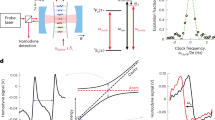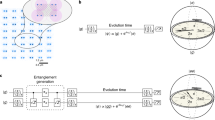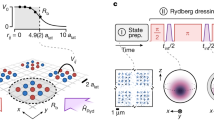Abstract
State-of-the-art atomic clocks are based on the precise detection of the energy difference between two atomic levels, which is measured in terms of the quantum phase accumulated over a given time interval1,2,3,4. The stability of optical-lattice clocks (OLCs) is limited both by the interrupted interrogation of the atomic system by the local-oscillator laser (Dick noise5) and by the standard quantum limit (SQL) that arises from the quantum noise associated with discrete measurement outcomes. Although schemes for removing the Dick noise have been recently proposed and implemented4,6,7,8, performance beyond the SQL by engineering quantum correlations (entanglement) between atoms9,10,11,12,13,14,15,16,17,18,19,20 has been demonstrated only in proof-of-principle experiments with microwave clocks of limited stability. The generation of entanglement on an optical-clock transition and operation of an OLC beyond the SQL represent important goals in quantum metrology, but have not yet been demonstrated experimentally16. Here we report the creation of a many-atom entangled state on an OLC transition, and use it to demonstrate a Ramsey sequence with an Allan deviation below the SQL after subtraction of the local-oscillator noise. We achieve a metrological gain of \(4.{4}_{-0.4}^{+0.6}\) decibels over the SQL by using an ensemble consisting of a few hundred ytterbium-171 atoms, corresponding to a reduction of the averaging time by a factor of 2.8 ± 0.3. Our results are currently limited by the phase noise of the local oscillator and Dick noise, but demonstrate the possible performance improvement in state-of-the-art OLCs1,2,3,4 through the use of entanglement. This will enable further advances in timekeeping precision and accuracy, with many scientific and technological applications, including precision tests of the fundamental laws of physics21,22,23, geodesy24,25,26 and gravitational-wave detection27.
This is a preview of subscription content, access via your institution
Access options
Access Nature and 54 other Nature Portfolio journals
Get Nature+, our best-value online-access subscription
$29.99 / 30 days
cancel any time
Subscribe to this journal
Receive 51 print issues and online access
$199.00 per year
only $3.90 per issue
Buy this article
- Purchase on Springer Link
- Instant access to full article PDF
Prices may be subject to local taxes which are calculated during checkout




Similar content being viewed by others
Data availability
All data obtained in the study are available from the corresponding author upon reasonable request.
References
Ludlow, A. D., Boyd, M. M., Ye, J., Peik, E. & Schmidt, P. O. Optical atomic clocks. Rev. Mod. Phys. 87, 637–701 (2015).
Ushijima, I., Takamoto, M., Das, M., Ohkubo, T. & Katori, H. Cryogenic optical lattice clocks. Nat. Photon. 9, 185–189 (2015).
Oelker, E. et al. Demonstration of 4.8 × 10−17 stability at 1 s for two independent optical clocks. Nat. Photon. 13, 714–719 (2019).
Schioppo, M. et al. Ultrastable optical clock with two cold-atom ensembles. Nat. Photon. 11, 48–52 (2017).
Dick, G. J. Local Oscillator Induced Instabilities in Trapped Ion Frequency Standards. Report ADA502386 (California Institute of Technology, Pasadena Jet Propulsion Lab, 1987); https://apps.dtic.mil/sti/citations/ADA502386.
Norcia, M. A. et al. Seconds-scale coherence on an optical clock transition in a tweezer array. Science 366, 93–97 (2019).
Takamoto, M., Takano, T. & Katori, H. Frequency comparison of optical lattice clocks beyond the dick limit. Nat. Photon. 5, 288–292 (2011).
Nicholson, T. L. et al. Comparison of two independent Sr optical clocks with 1×10−17 stability at 103 s. Phys. Rev. Lett. 109, 230801 (2012).
Appel, J. et al. Mesoscopic atomic entanglement for precision measurements beyond the standard quantum limit. Proc. Natl Acad. Sci. USA 106, 10960–10965 (2009).
Takano, T., Fuyama, M., Namiki, R. & Takahashi, Y. Spin squeezing of a cold atomic ensemble with the nuclear spin of one-half. Phys. Rev. Lett. 102, 033601 (2009).
Gross, C., Zibold, T., Nicklas, E., Esteve, J. & Oberthaler, M. K. Nonlinear atom interferometer surpasses classical precision limit. Nature 464, 1165–1169 (2010).
Riedel, M. F. et al. Atom-chip-based generation of entanglement for quantum metrology. Nature 464, 1170–1173 (2010).
Schleier-Smith, M. H., Leroux, I. D. & Vuletić, V. Squeezing the collective spin of a dilute atomic ensemble by cavity feedback. Phys. Rev. A 81, 021804 (2010).
Leroux, I. D., Schleier-Smith, M. H. & Vuletić, V. Implementation of cavity squeezing of a collective atomic spin. Phys. Rev. Lett. 104, 073602 (2010).
Kruse, I. et al. Improvement of an atomic clock using squeezed vacuum. Phys. Rev. Lett. 117, 143004 (2016).
Pezzè, L., Smerzi, A., Oberthaler, M. K., Schmied, R. & Treutlein, P. Quantum metrology with nonclassical states of atomic ensembles. Rev. Mod. Phys. 90, 035005 (2018).
Cox, K. C., Greve, G. P., Weiner, J. M. & Thompson, J. K. Deterministic squeezed states with collective measurements and feedback. Phys. Rev. Lett. 116, 093602 (2016).
Hosten, O., Engelsen, N. J., Krishnakumar, R. & Kasevich, M. A. Measurement noise 100 times lower than the quantum-projection limit using entangled atoms. Nature 529, 505–508 (2016).
Bohnet, J. G. et al. Quantum spin dynamics and entanglement generation with hundreds of trapped ions. Science 352, 1297–1301 (2016).
Braverman, B. et al. Near-unitary spin squeezing in Yb 171. Phys. Rev. Lett. 122, 223203 (2019).
Wcisło, P. et al. New bounds on dark matter coupling from a global network of optical atomic clocks. Sci. Adv. 4, eaau4869 (2018).
Safronova, M. S. et al. Search for new physics with atoms and molecules. Rev. Mod. Phys. 90, 025008 (2018).
Safronova, M. S. The search for variation of fundamental constants with clocks. Ann. Phys. 531, 1800364 (2019).
Lisdat, C. et al. A clock network for geodesy and fundamental science. Nat. Commun. 7, 12443 (2016).
Grotti, J. et al. Geodesy and metrology with a transportable optical clock. Nat. Phys. 14, 437–441 (2018).
Takamoto, M. et al. Test of general relativity by a pair of transportable optical lattice clocks. Nat. Photon. 14, 411–415 (2020).
Kolkowitz, S. et al. Gravitational wave detection with optical lattice atomic clocks. Phys. Rev. D 94, 124043 (2016).
Wineland, D. J., Bollinger, J. J., Itano, W. M. & Heinzen, D. J. Squeezed atomic states and projection noise in spectroscopy. Phys. Rev. A 50, 67–88 (1994).
Kitagawa, M. & Ueda, M. Squeezed spin states. Phys. Rev. A 47, 5138–5143 (1993).
Hamley, C. D., Gerving, C., Hoang, T., Bookjans, E. & Chapman, M. S. Spin-nematic squeezed vacuum in a quantum gas. Nat. Phys. 8, 305–308 (2012).
Leroux, I. D., Schleier-Smith, M. H. & Vuletić, V. Orientation-dependent entanglement lifetime in a squeezed atomic clock. Phys. Rev. Lett. 104, 250801 (2010).
Wineland, D. J. et al. Experimental issues in coherent quantum-state manipulation of trapped atomic ions. J. Res. Natl. Inst. Stand. Technol. 103, 259–328 (1998).
Braverman, B., Kawasaki, A. & Vuletić, V. Impact of non-unitary spin squeezing on atomic clock performance. New J. Phys. 20, 103019 (2018).
Matei, D. G. et al. 1.5μm lasers with sub-10 MHz linewidth. Phys. Rev. Lett. 118, 263202 (2017).
Hu, L., Poli, N., Salvi, L. & Tino, G. M. Atom interferometry with the Sr optical clock transition. Phys. Rev. Lett. 119, 263601 (2017).
Pospelov, M. et al. Detecting domain walls of axionlike models using terrestrial experiments. Phys. Rev. Lett. 110, 021803 (2013).
Riehle, F. Optical clock networks. Nat. Photon. 11, 25–31 (2017).
Al-Masoudi, A., Dörscher, S., Häfner, S., Sterr, U. & Lisdat, C. Noise and instability of an optical lattice clock. Phys. Rev. A 92, 063814 (2015).
Kawasaki, A. et al. Geometrically asymmetric optical cavity for strong atom-photon coupling. Phys. Rev. A 99, 013437 (2019).
Blatt, S. et al. Rabi spectroscopy and excitation inhomogeneity in a one-dimensional optical lattice clock. Phys. Rev. A 80, 052703 (2009).
Vallet, G. et al. A noise-immune cavity-assisted non-destructive detection for an optical lattice clock in the quantum regime. New J. Phys. 19, 083002 (2017).
Yamoah, M. et al. Robust kHz-linewidth distributed Bragg reflector laser with optoelectronic feedback. Opt. Express 27, 37714–37720 (2019).
Zhang, W. et al. Reduction of residual amplitude modulation to 1×10−6 for frequency modulation and laser stabilization. Opt. Lett. 39, 1980–1983 (2014).
Śliwczyński, Ł., Krehlik, P., Czubla, A., Buczek, Ł. & Lipiński, M. Dissemination of time and RF frequency via a stabilized fibre optic link over a distance of 420 km. Metrologia 50, 133 (2013).
Lee, W. et al. Ultrastable laser system using room-temperature optical cavity with 4.8×10−17 thermal noise limit. In 2019 Joint Conference of the IEEE International Frequency Control Symposium and European Frequency and Time Forum 1–2 (IEEE, 2019).
Acknowledgements
We thank H. Katori, W. Ketterle, A. Ludlow, M. Lukin, J. Ramette, G. Roati, A. Urvoy, Z. Vendeiro and J. Ye for discussions. This work was supported by NSF, DARPA, ONR and the NSF Center for Ultracold Atoms (CUA). S.C. and A.F.A. acknowledge support from the Swiss National Science Foundation (SNSF). B.B. acknowledges support from the National Science and Engineering Research Council of Canada.
Author information
Authors and Affiliations
Contributions
A.K., B.B., C.S., E.P.-P., S.C., A.F.A., Z.L., E.M. and V.V. contributed to the building of the experiment. E.P.-P., S.C. and C.S. led the experimental efforts and simulations. S.C., A.F.A., C.S. and E.P.-P. contributed to the data analysis. V.V. conceived and supervised the experiment. S.C. and V.V. wrote the manuscript. All authors discussed the experiment implementation and results and contributed to the manuscript.
Corresponding author
Ethics declarations
Competing interests
The authors declare no competing interests.
Additional information
Peer review information Nature thanks the anonymous reviewer(s) for their contribution to the peer review of this work. Peer reviewer reports are available.
Publisher’s note Springer Nature remains neutral with regard to jurisdictional claims in published maps and institutional affiliations.
Supplementary information
Rights and permissions
About this article
Cite this article
Pedrozo-Peñafiel, E., Colombo, S., Shu, C. et al. Entanglement on an optical atomic-clock transition. Nature 588, 414–418 (2020). https://doi.org/10.1038/s41586-020-3006-1
Received:
Accepted:
Published:
Issue Date:
DOI: https://doi.org/10.1038/s41586-020-3006-1
This article is cited by
-
Verifying the security of a continuous variable quantum communication protocol via quantum metrology
npj Quantum Information (2024)
-
Multi-ensemble metrology by programming local rotations with atom movements
Nature Physics (2024)
-
Cavity-mediated long-range interactions in levitated optomechanics
Nature Physics (2024)
-
Theoretical guarantees for permutation-equivariant quantum neural networks
npj Quantum Information (2024)
-
Graph states of atomic ensembles engineered by photon-mediated entanglement
Nature Physics (2024)
Comments
By submitting a comment you agree to abide by our Terms and Community Guidelines. If you find something abusive or that does not comply with our terms or guidelines please flag it as inappropriate.



